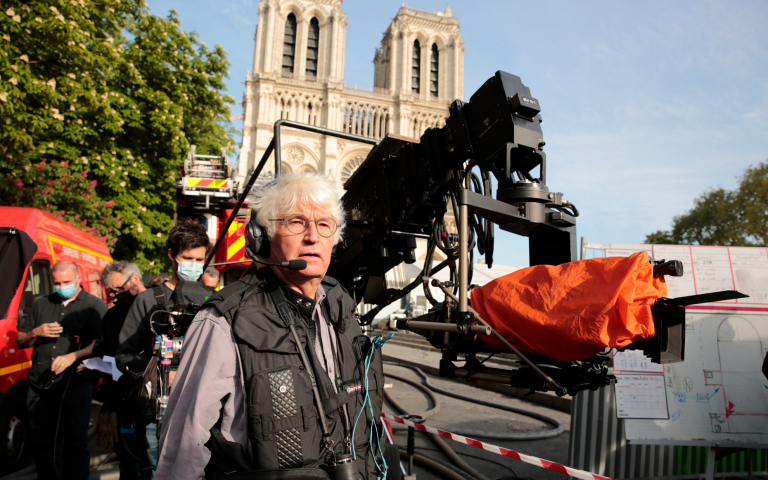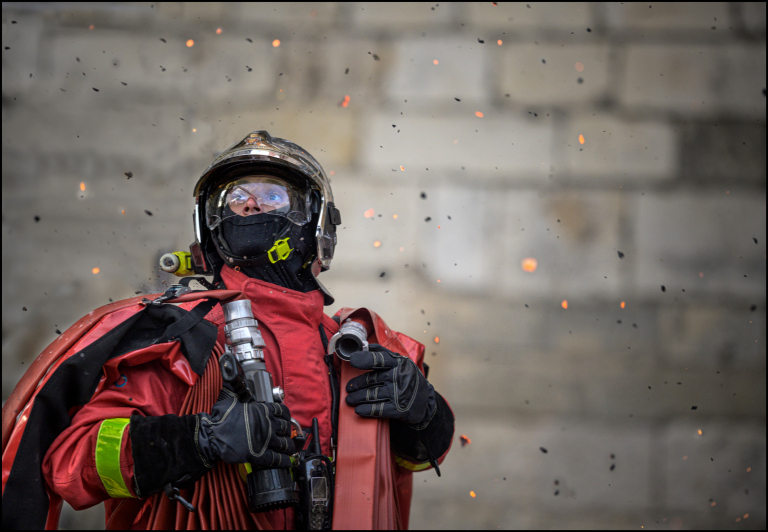
"Notre-Dame on Fire" will be released on Wednesday, one month before the anniversary of the fire that ravaged the Cathedral in April 2019. The director Jean-Jacques Annaud and his teams carried out a colossal reconstruction at the Cité du Cinéma and in Bry-sur Marne in order to plunge viewers into the heart of the burning building. Film Paris Region supported the film during the preparation of this exceptional filming.
Key Figures
-
days of filming in Paris Region, 65 days in all
52
-
month of post-production
12
-
65 hours of work performed by 450 intermittent workers in Paris Region
175 000
Synopsis
Notre-Dame on fire follows the work of these men and women in the field in the bowels of this 4,800 m² cathedral nestled in the heart of Paris during the 15 hours of the fire.
Tournage
The film, with a budget of 31.5 million euros, including 480,000 euros of aid from the Île-de-France region, mobilized a large number of resources in the region: technicians, local companies and locations.
This historic fire due to its magnitude was also heroic and incredible in its rescue. It was incredible due to a series of incidents that delayed the arrival of the emergency services on site, and heroic due to the fact that the mobilized firefighters had to face extraordinary technical and physical difficulties.
Jean-Jacques Annaud was very quickly aware of the cinematographic potential of this event, which became a worldwide event in a few hours. With the support of Pathé, he quickly decided to take it to the cinema. He set out on this project with two goals in mind: to pay tribute to the work of the 600 firefighters and other professionals who were mobilized to extinguish the fire and save as the building and as many relics as possible; and to produce an exceptional action film that combines both emotion and suspense.

(There were) all the ingredients of a fictional scenario: in the lead role, an international star, Notre-Dame of Paris. Her enemy: a fearsome and charismatic demon, fire. In between, humble young men who are ready to sacrifice their lives to save stones.
The choice of SFX
Accustomed to innovations and exceptional devices, Jean-Jacques Annaud wanted to recreate the physical sensations that the firemen experienced in this project. Rather than reproduce the fire in post-production with visual effects (VFX), he decided to use special effects filmed during the filming (SFX). This choice had repercussions on the budget and on the time needed to prepare the filming.
Indeed, since the Cathedral is largely destroyed and inaccessible, extensive research work was necessary to recreate the parts of the building that were filmed and set on fire.
The director and his team visited several cathedrals to gather the information they needed for an accurate reproduction: the Basilica of Saint-Denis in Paris Region and the cathedrals of Amiens, Bourges and Sens in the provinces. A small group of people also went to the Cathedral of Notre-Dame to check the location.
The production team then moved to the Cité du Cinéma in Seine Saint-Denis to begin the drawings, 3D modeling, and mock-ups needed to make decisions. Everything was created according to the original blueprints thanks to the recruitment of 6 qualified architects.
In the meantime, the teams of Jean-Christophe Magnaud, SFX supervisor, developed the technical means necessary to set fire to the sets, while complying with safety constraints. A challenge which combined technical and artistic expertise, and which now has allowed him to be acclaimed by major international productions.
From preparation to reconstruction
The iconic parts of the tragedy: The nave, the spiral staircase, the exterior passageways, the framework of the north transept and the interior of the bell tower were rebuilt on a scale of 1 between the studios in Saint-Denis and the backlot in Bry sur Marne.
To meet this challenge, Jean-Jacques Annaud called on the production designer Jean Rabasse, who won the César for best set design in 1996 for the film by Jean-Pierre Jeunet and Marc Caro The City of Lost Children. All the professions were mobilized: architects, ironworkers, glaziers, painters, plasterers, etc., i.e. over 150 technicians, not counting the contractors.
The set design had to be faithful to the original blueprints, but at the same time had to be able to integrate the technical elements that were needed to create the special effects.
Many of the sets created for the film were recycled at the end of the project: the belfry was sold to Americans; the structure of the transept was dismantled to build houses in Brittany etc.
Jean Rabasse, Top set Designer
Filming and post-production
The filming took place from mid-March to mid-June 2021 with a constant concern for authenticity and emotion. The film crew was exceptionally allowed to film some scenes on the Cathedral's square. They also used anonymous video footage during the tragedy.
For the fire scenes, fireproof cameras and crash boxes were created and every member of the crew exposed to the fire was given the same protection as the firemen.
The Paris Region Fire Department was called upon both during the pre-filming phase to help recreate the firefighters' route during the fire, and during the filming phase, when 10 firefighters were present during the fire sequences in the sets.
Although SFX was favored, 400 shots out of the 1600 that make up the film were reworked in post-production with visual effects, under the supervision of Laurens Ehrmann of Mikros.
To reinforce the immersive feeling, Jean-Jacques Annaud placed particular importance on sound. Every sound detail became part of the story. He and his team worked carefully in post-production to reproduce certain sounds in a clear and identifiable way.
The film will be shown in theaters equipped with Dolby Atmos technology, a 3D sound technology that provides an immersive experience through more than seventy speakers spread out horizontally and vertically around and on the theater's ceiling.
